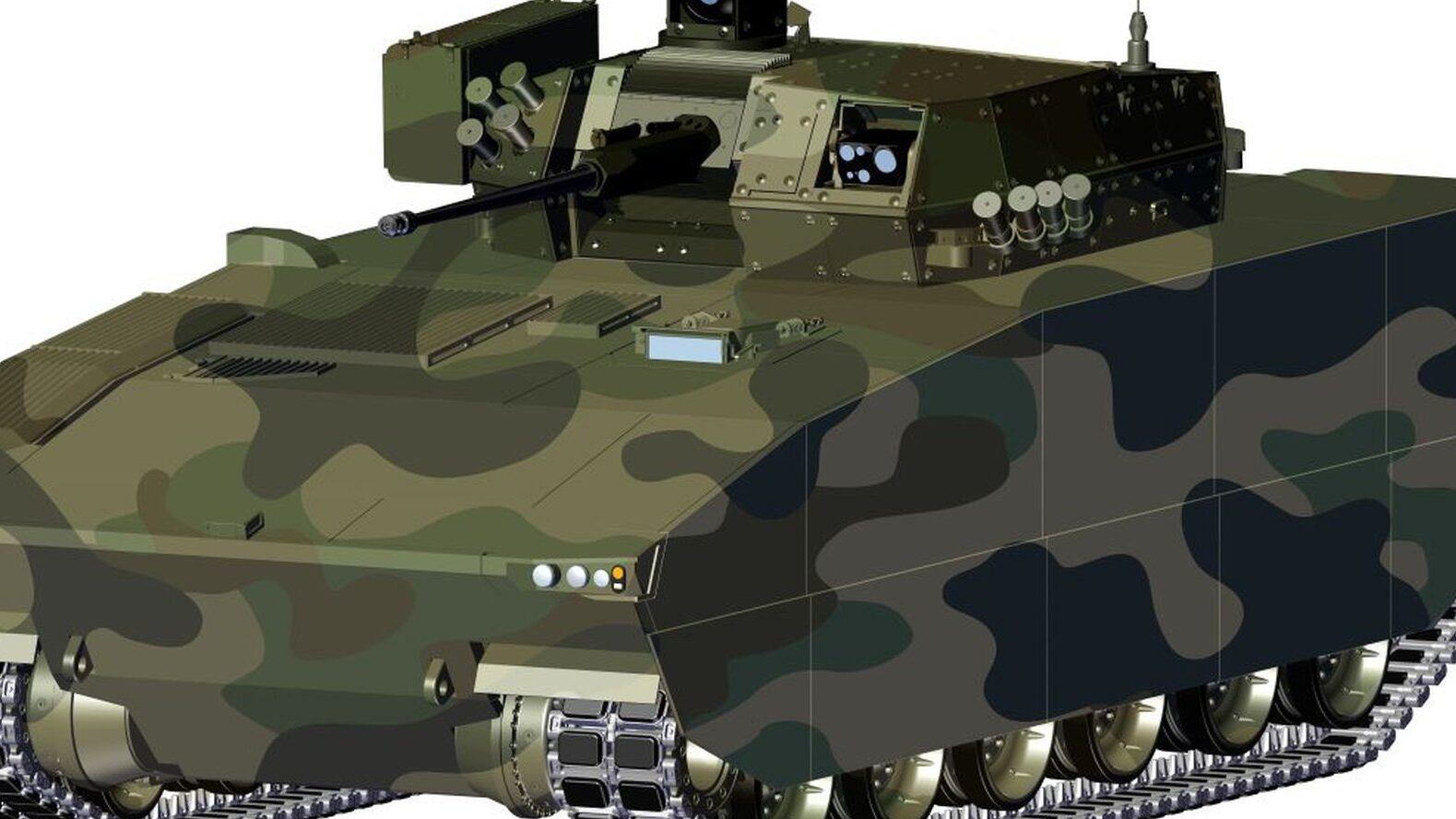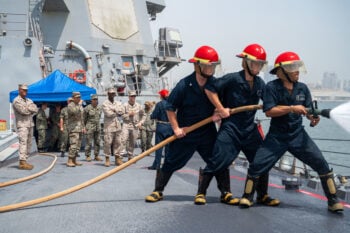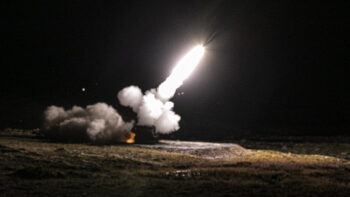
Concept art for Poland’s heavy infantry combat vehicle, the Ciężki Bojowy Wóz Piechoty. (Polish MND)
WARSAW — The companies of the Polish Armaments Group (PGZ) this morning announced a trio of new contracts with the Poland’s MND Armament Agency: one for the supply of nearly 400 Lekki Pojazd Rozpoznawczy (LPR, Light Reconnaissance Vehicles) and two framework contracts for the supply of Ciężki Bojowy Wóz Piechoty (CBWP, Heavy Infantry Combat Vehicles) and a Nowy Kołowy Transporter Opancerzony (NKTO, New Wheeled Armored Personnel Carriers).
It’s a continuation of Poland’s massive defense spending spree of the last two years, which has seen Warsaw throw what a top officer told Breaking Defense are proverbial “suitcases with money” at modernizing its military. Among the splashy orders were Abrams tanks, Apache combat helicopters and HIMARS rocket launchers from the United States, South Korean-made K2 tanks, Chunmoo rocket launchers, K9 self-propelled howitzers and FA-50 combat aircraft, and at least two Swedish early warning aircraft to complement additional tethered warning systems.
The first of today’s three contracts, signed by the consortium of PGZ and Rosomak, covers the supply of approximately 400 LPRs in a 4×4 chassis. The approximately PLN 1.2 billion ($290 million) contract comes with a delivery period between 2024 and 2030.
“The LPRs that we ordered in the amount of 400 units will be produced in a very short time at the Rosomak plant (in Siemianowice Śląskie in Poland). The vehicle meets the needs of the Polish Army. We are already going down in history with the era of the [Polish multi-purpose off-road vehicle] Honkers and various such vehicles. We intend to introduce this vehicle to the Polish Army as soon as possible,” said Polish Defense Minister Mariusz Błaszczak.
The LPR is a polonization of the Korean family of KIA KLTV vehicles, continuing the growing military relationship between South Korea and Poland. The vehicle will receive a new, modernized body prepared for the needs of the Polish military; the MND expects to adjust the design over time as it gets more feedback from Polish military users. Over the next few years, Rosomak plans to gradually transfer the production of vehicle components to Poland, starting with the transfer of body production technology.
RELATED: With live field experimentation, Poland shapes its future force
The vehicle is equipped with armor providing ballistic protection at level I of NATO standard STANAG 4569, and it is powered by a 225 HP diesel engine. It also has a central tire inflation system and a runflat system for driving after a puncture of tires.
The LPR will be equipped with a turntable on the roof enabling the installation of a 7.62mm or 12.7mm machine gun, or a 40mm grenade launcher. The permissible weight of the LPR is approx. 5.7 tons, helping to fill the gap between light vehicles and heavier systems.
Heavy Infantry Fighting Vehicle: Ciężki Bojowy Wóz Piechoty
The second framework contract signed by the consortium of PGZ and Huta Stalowa Wola will result in the delivery of several hundred modern Heavy Infantry Fighting Vehicles in various configurations, collectively referred to as CBWPs. (Pricing details were not made public for either two framework contracts announced today.)
The implementation of the framework will allow the first CBWP to be delivered to the Polish Armed Forces in 2025, together with a logistics and training package. The agreement also includes the expansion of the production and service infrastructure.
“The CBWP is the implementation of the idea regarding the use of technology that was already owned by the PGZ for the benefit of the Polish Army. […] We are dealing here with an idea that goes beyond the framework, but this idea is carried out in such a way as to equip the troops with a CBWP in a short time,” said Mariusz Błaszczak, Poland’s Minister of National Defense.
Podpisano dziś również dwie umowy ramowe. Pierwsza z nich dotyczy zakupu z dostosowaniem kilkuset Ciężkich Bojowych Wozów Piechoty #CBWP. Pierwszy pojazd w #WojskoPolskie już w 2025 roku.https://t.co/kD9eMHRywX pic.twitter.com/1DAaEGhHNH
— Agencja Uzbrojenia (@AgencjaUzbr) August 14, 2023
Among the configurations is the use of the domestically built ZSSW-30 remotely controlled turret system, developed by HSW together with WB Electronics. The main armament of the ZSSW-30 is the 30mm Bushmaster Mk.44S automatic chain gun, able to fire with five different types of ammunition, including programmable ammunition. The auxiliary armament, integrated with the turret, is a modified 7.62mm UKM-2000C machine gun coupled with the cannon, as well as double anti-tank guided missiles launchers. Currently, the Spike-LR ATGM launcher has been integrated into the turret, but integration with the Javelin ATGM is also being considered in the future.
The chassis of the CBWP will be made using elements of the Krab self-propelled gun-howitzer with the ZSSW-30. The vehicle will enable the transport of a three-person crew and eight soldiers and will provide fire support to the transported squad in all weather conditions, day and night.
The main task of the CBWP will be to engage armored and unarmored targets, incapacitate and destroy exposed fire means, manpower, shelters and field fortifications in direct contact with the enemy. It will also have a high level of ballistic and anti-mine protection, as well as traction capabilities.
New Wheeled Armored Personnel Carrier: Nowy Kołowy Transporter Opancerzony
The subject of the last, but not least, framework contract concluded is the delivery in the 2028-2035 to what the government calls several hundred (according to a PGZ release, nearly a thousand) NKTO in the combat version, equipped with a Remotely Controlled Weapon System (ZSMU), plus logistics and training packages.
The NKTO is to be another domestic product, alongside the NBPWP Borsuk, designed from scratch on the basis of the experience and competence of Polish defense industry. Currently, preparations are underway to negotiate an executive contract with the military regarding the development of a vehicle, the rights to which will remain in Poland.
Warsaw seeks the ability to develop subsequent generations of NKTOs, and the acquisition of intellectual property rights to the results of development work will enable the Polish industry to do serial production of NKTOs. In addition, there will be no limits on exportability; While PGZ could work with foreign partners in the future, NKTO design with foreign partners is not planned at the current stage.
“Rosomak APC is a good product, but this license, this deal was not the best. There are limitations when it comes to the development of this product. […] We took up the challenge of developing a new version of this vehicle. I am convinced that it will be a hit, it will be an export hit. First of all, the needs of the Polish Army, but we also try to ensure that these products can be exported,” Błaszczak added.
However, this system appears the farthest from getting in the hands of Polish forces.
Under the contract, the company will stand up the ability to develop and manufacture a NKTO, maintain technological and organizational processes guaranteeing constant deliveries of transporters, perform maintenance and repair tasks and repairs at the plant level, as well as support the operation in the form of supplies of spare parts.
The implementation of the framework contract for the supply of a new APC will result in the conclusion of a contract for development work, which will allow for the acquisition of competences and know-how enabling the production of a domestic NKTO. The agreement also provides for integration with a ZSSW-30 system, as well as with a ZSMU, which will be developed as part of the above-mentioned development work.
Aloha: Fixes ongoing, then Army’s new watercraft prototype is Hawaii bound for testing
“Everything that we can knock off that list we will do in the archipelago…because that allows us to do the tests in the environment that the vessel will operate in ultimately,” said Maj. Gen. Jered Helwig.


























